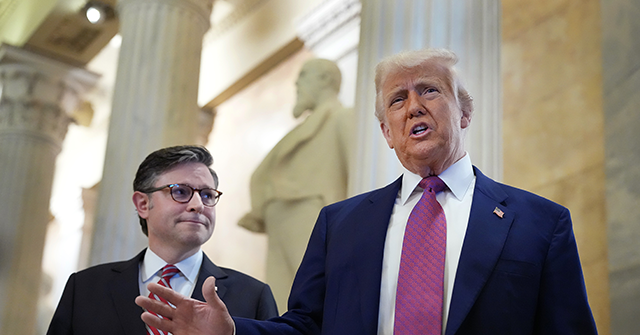Tax Cuts Don’t Raise Interest Rates
Opponents of President Donald Trump’s “One Big Beautiful Bill” are turning once again to their most familiar weapon: the deficit forecast.
The famous Penn Wharton Budget Model (PWBM) says the bill will add $3.3 trillion to the federal debt over ten years, and so the usual chorus begins—claims that interest rates will rise, private investment will suffer, and the tax cuts will harm future generations.
But this line of attack depends on a critical assumption—one that doesn’t hold up against the last three decades of economic reality.
Debt and Rates: A Link That Isn’t There
The Penn Wharton Budget Model rests on a simple, elegant logic: when the government borrows more, it competes with the private sector for capital. That drives up interest rates, discourages business investment, and cancels out the growth you might get from tax relief.
The problem is, we’ve lived through the test case—and it didn’t happen. Since the 1990s, the U.S. debt-to-GDP ratio has soared from under 40 percent to more than 120 percent. Yet interest rates have mostly fallen. Even during periods of rapid borrowing, including after the 2017 tax cuts, bond yields remained historically low. There was no crowding out, no investment slump, and no spike in the cost of capital.
PWBM’s forecasts don’t explain this because their model treats capital as domestically scarce. In reality, the United States is the anchor of the global financial system. It draws in savings from around the world, largely because economic policies adopted by the rest of the world—and passively accepted by the open economy of the U.S.—result in the foreign accumulation of dollars through trade surpluses with the United States. When foreign countries export more to the U.S. than we import, dollars flow into the coffers of foreign producers—who, in turn, recycle them into U.S. financial assets. This includes buying massive amounts of Treasury debt.
That steady capital inflow puts downward pressure on interest rates—even as federal borrowing rises. It’s not that deficits are free of consequences. But the idea that borrowing automatically triggers higher rates simply isn’t supported by what’s happened in our economy.
A Different Constraint, A Better Policy
This doesn’t mean there’s no limit to what the U.S. government can borrow. It means that interest rates are shaped by more than just the level of public debt. Trade balances, global demand for dollar-denominated assets, domestic savings behavior, and monetary policy all play critical roles.
If we focus exclusively on the debt-to-GDP ratio, we miss the deeper picture: what matters most is whether new borrowing is put to productive use. That’s where Trump’s Big Beautiful Bill comes in.
The bill isn’t just a political showpiece. It’s a serious attempt to strengthen labor incentives, promote domestic investment, and restore growth in regions left behind. By exempting tips and overtime from income taxes, it rewards work at the margins. By making full expensing permanent, it reduces the cost of capital for small businesses and manufacturers. By expanding Opportunity Zones to rural America, it channels investment into places long bypassed by the modern economy.
These are real, structural changes—and they don’t require a fantasy scenario to justify themselves. If interest rates remain stable, as they have for decades despite rising debt, then the standard arguments against tax-driven growth policies start to fall apart.
Why PWBM Keeps Getting It Wrong
The reason PWBM can’t see this is because their model is built to assume fiscal limits that kick in automatically. Every dollar borrowed is presumed to push up rates. Every point of GDP added to the debt is a drag on growth. That’s the logic chain. It’s neat. It’s tidy. It’s also disconnected from how capital flows actually work in a global economy.
The Council of Economic Advisers under Trump understands this better. In their analysis of the Big Beautiful Bill, they model the tax cuts without assuming rising rates—and project robust results: four to five percent higher GDP, millions of jobs added, and meaningful income gains for working families. They base their optimism not on wishful thinking, but on the very experience we lived through after the 2017 tax cuts.
Interest rates didn’t spike then. There’s no reason to assume they will now.
We should always treat federal borrowing with caution. But caution is not the same as paralysis. The Big Beautiful Bill doesn’t defy economic gravity. It reflects the actual conditions of the world we live in—where global capital seeks safe, stable investments, and where the U.S. government remains the issuer of the world’s most trusted debt. So long as the rest of the world continues to deploy policies meant to create trade deficits for the U.S. and trade surpluses abroad, the demand for the debt securities of the U.S. from foreign investors will remain strong. (And, if President Trump’s trade policies bring imports and exports into a better balance, the additional income within the U.S. will be able to replace foreign buyers.)
What matters is whether tax policy boosts productivity, rewards work, and encourages private sector growth. The Big Beautiful Bill is designed to do exactly that.
The real risk isn’t that interest rates will suddenly explode because of a model’s projection. The real risk is that we let abstract fears override real opportunities to strengthen the American economy.
Read the full article here
